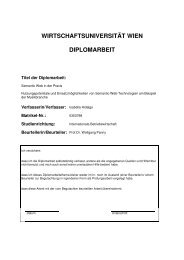Wirtschaftsuniversität Wien Magisterarbeit - SemanticLab
Wirtschaftsuniversität Wien Magisterarbeit - SemanticLab
Wirtschaftsuniversität Wien Magisterarbeit - SemanticLab
Create successful ePaper yourself
Turn your PDF publications into a flip-book with our unique Google optimized e-Paper software.
for example, not unproblematic to be a government critical blogger 2 in all countries.<br />
Taking a look at the censorship in the People’s Republic of China or the limited access<br />
to the Internet in China the question has to be raised how opinions can be published<br />
without the fear of imprisonment or other sanctions [Pau07]. Privacy is the ultimate<br />
goal here. In such an environment, privacy can only be achieved by using technology<br />
(such as anonymous proxies or virtual private networks (VPN)) to stay anonymous while<br />
browsing the web and publishing content on the web [Opp05].<br />
2.3. Privacy sensitive applications<br />
After introducing threats to financial, medical and political privacy, common privacy<br />
sensitive applications should be introduced. Such applications use personal data to<br />
perform a certain service to the user. Therefore, popular services on the Internet that<br />
use such sensitive data will be discussed and arising threats will be highlighted. The<br />
following categorization of web-applications is based on [Kob07].<br />
2.3.1. Personalization<br />
Personalization has a different meaning in different industries. As this thesis is focused<br />
on the World Wide Web, the definition of the Personalization Consortium (cited in<br />
[Ves07]) will be used:<br />
Personalization is the use of technology and customer information to tailor<br />
electronic commerce interactions between a business and each individual customer.<br />
Using information either previously obtained or provided in real-time<br />
about the customer, the exchange between the parties is altered to fit that<br />
customers stated needs as well as needs perceived by the business based on<br />
the available customer information.<br />
This definition was chosen for two reasons: first of all, it explains what personalization is.<br />
But more importantly, it emphasizes the need of data to actually provide personalization.<br />
Newspaper websites for example can often be adapted to one’s needs - if wished, they<br />
will only display sports articles, the daily cartoon and articles on foreign affairs. Of<br />
course, this is very useful but on the other hand this information can be used to create<br />
profiles about users. If a website “knows” what articles users read, it may conclude which<br />
preferences users may have. Certainly, equipped with this knowledge, it will only display<br />
advertisements which fit to users’ preferences [Miy08]. However, most big websites offer<br />
some personalization to its users [Kob07]. Taking a look at one of the most popular<br />
search engines - Google. With “iGoogle” users can customize the start page of Google to<br />
their specific needs. Users can not only select their preferred language, they can display<br />
selected news, weather forecasts and other gadgets such as Sudokus. Taking an isolated<br />
look at every service does not reveal any threat to privacy. But if users access their news<br />
2 A “blogger” is a person which regularly posts (personal) information on a website in journal style (a<br />
“blog”)<br />
9





